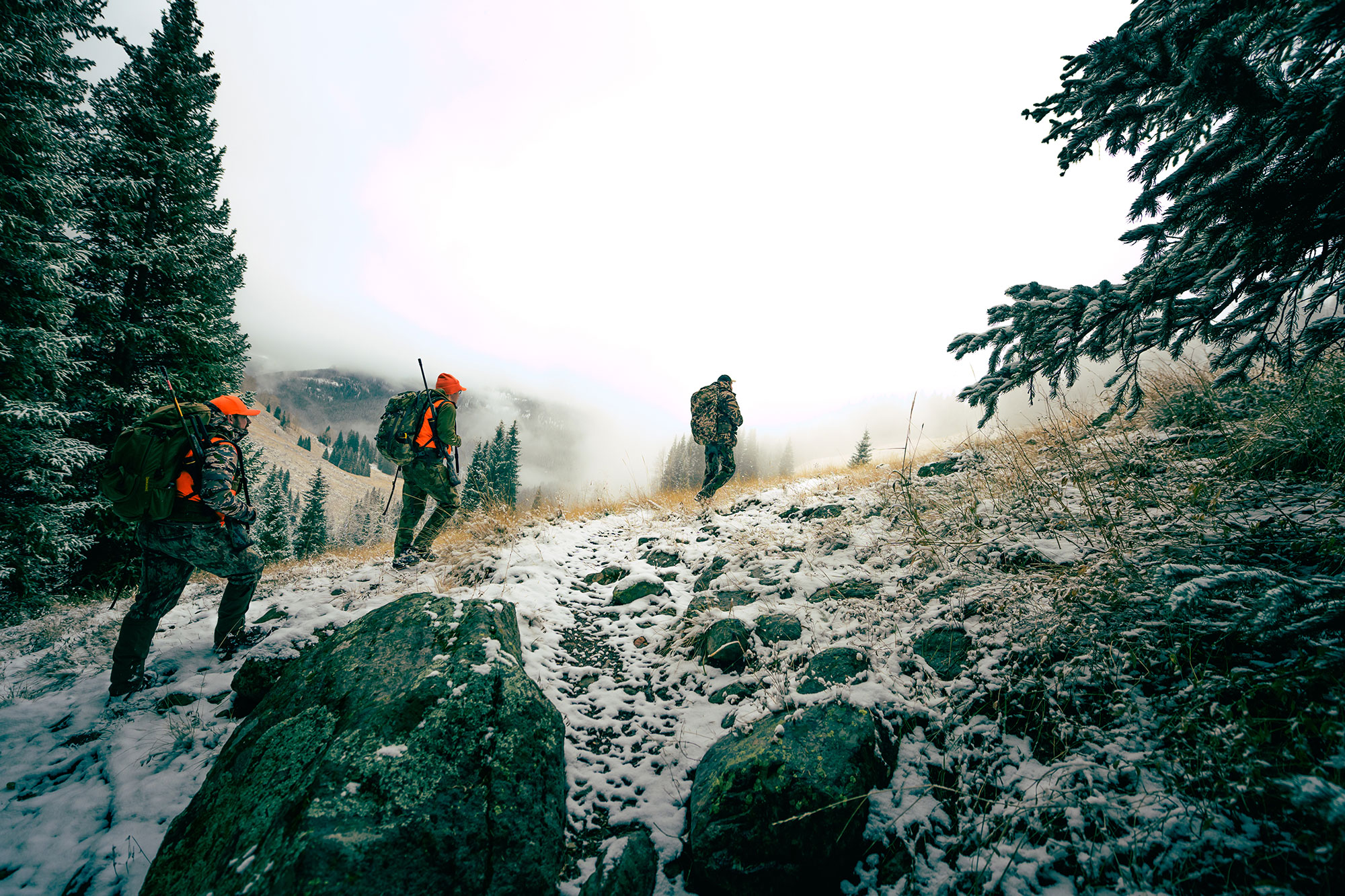We may earn revenue from the products available on this page and participate in affiliate programs. Learn More ›
Coming up with a list of the best dangerous game cartridges is a tricky thing. The difficulty isn’t so much about where to start. There’s a generally accepted idea for what qualifies as a minimally adequate dangerous game round. But rather where does one stop?
One issue is size. You could rocket right to the top and include the .700 Nitro Express, .600 Nitro Express, the .577s, and others of that ilk—and you wouldn’t be wrong. They will instantly turn the lights off on anything you hit between the eyes, and no one could tell you otherwise.
I chose not to go that route because these rounds are only available in a vanishingly small number of very expensive rifles that tend to be extremely heavy—making them impractical for all-day carry—and generate a level of recoil few shooters could hope to master. The only reasonable use of such cartridges is as a back-up gun for elephant, particularly in thick cover.
The other issue is obscurity. The history of dangerous game calibers is long and rich with variants upon variants, all with—to this rifle nerd at least—interesting stories behind them. You can start with something like the .470 NE, which is on the list, and then pivot to the .450 3 ¼ in. NE (which is the reason the .470 came to be), and then to the .465 NE, the .475 NE, the .475 No. 2 NE, the .476 NE…and you get the point. For those wanting to travel that path, I suggest picking up African Rifles and Cartridges by John Taylor and pouring yourself a glass of fine whiskey.
Instead, I focused on dangerous game cartridges that are chambered in sporting rifles that are relatively attainable and that enjoy the support of major gun and ammunition companies.
This list is also based on my personal experiences. Over the years I’ve had elephant try to run me over, engaged in standoffs with grizzlies in dark timber, and had to follow wounded Cape buffalo into nearly impenetrable mopane thickets. I’ve hunted brown bears in Alaska and have gone after the Big 5 in Africa. The cartridges here include those I’ve carried and have relied upon to keep me alive when things get hairy.
I know others will find fault with this list—mostly for having left off a personal favorite—but that’s okay. Limiting myself to ten helps keep a fence around the project and, honestly, I’m looking forward to hearing what others have to say about the ones I selected. So have at it.
.375 H&H Magnum
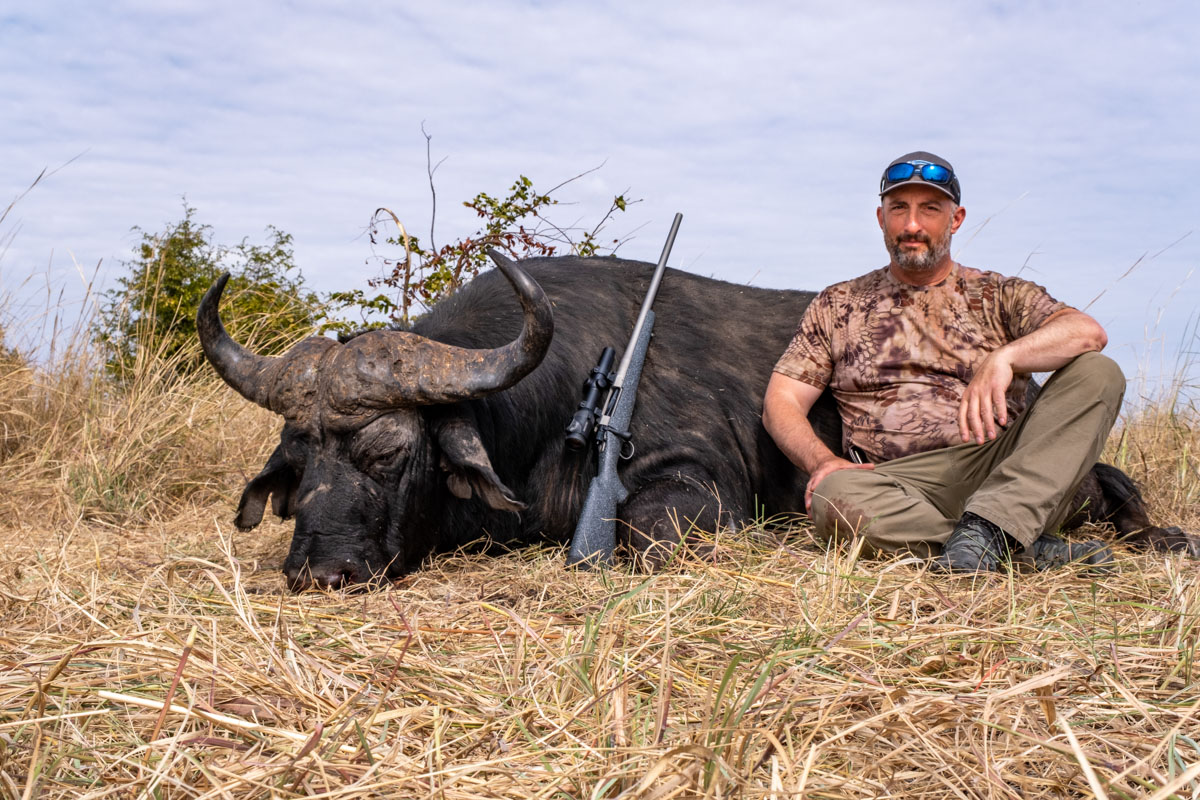
The .375 H&H is the king of big-game cartridges because there’s nothing it cannot handle, including dangerous game. It’s do-everything versatility and track record is unmatched, which is why it’s popularity over the decades trumps any other cartridge on this list. Hunters and guides from Alaska to Zambia swear by its ability to put down critters, no matter how thick their skin, sharp their teeth, or the length of their claws.
I’ve written about the charms of the .375 H&H before and have hunted with it extensively in Africa, Canada, Alaska, and the Lower 48—most recently on a trip to Zimbabwe where I shot a Cape buffalo dagga boy along with a number of plains game animals.
What accounts for the .375 H&H’s success? In short, it’s incredibly well balanced. It hits a sweet spot in terms of shootability, reliability, terminal performance, and practical accuracy on game. Added to this list is its availability. Whether you are in Fairbanks or Windhoek you’ll be able to find ammunition.
The standard loads are 300- and 270-grain bullets pushed at 2,400 and 2,690 fps respectively. The 300-grainers are the best dangerous game bullet and great for all-around hunting but the 270s work great on bears and medium-sized game and shoot a bit flatter.
Its drawbacks, such as they are, are minor. If you were going on an elephant hunt, it isn’t the best choice. There are other cartridges that handle that task better. At the other end of the spectrum, recoil sensitive shooters might find it a bit much to handle for smaller game, though in a rifle that has enough heft (and a well-designed stock with a good recoil pad) recoil isn’t much of an issue.
Those are mere quibbles, however. The .375 H&H caught on fairly quickly after it was unveiled in 1912—Winchester was the first American gun company to adopt the round in 1925—and it has been on a steady rise since. I wouldn’t want to live in a world where we didn’t have the .375 H&H and I’m glad to say that will never be the case.
.416 Rigby

During my first four trips to Africa, I carried just one rifle—a Ruger Magnum in .416 Rigby. That rifle accounted for everything from Cape buffalo to the diminutive duiker. It was (and still is) marvelously accurate, a 3-shot sub-MOA gun with 400-grain Nosler Partitions. Whatever I point the gun at flops over dead. Hunting guides love it when that happens, which is why they will grin and nod approvingly whenever a client arrives in camp with one.
I’m hardly the only one who’s fallen under the .416 Rigby’s spell. It originated in 1911 in the workshop of London gunmaker John Rigby & Co. and was the first cartridge to use a bullet of that caliber.
That era was a fertile time for cartridge development, especially for medium-bore big game rounds like the .416 Rigby. Two of the primary drivers of this were the development of smokeless gunpowder and the introduction of the Magnum Mauser 98 action. Their pairing was the ballistic equivalent of Reese’s melding of chocolate and peanut butter—utter perfection. Cordite powder allowed for smaller bullets to be driven at higher velocities without generating undo pressure, equaling (and in many ways bettering) the 19th Century big bore blackpowder rounds. The .416 and its peers fit into and fed from the Mauser 98 Magnum action with absolute reliability, setting the standard for magazine-fed turn-bolt repeaters.
A lot of companies load the .416 Rigby. I’ve had great success with Federal’s Safari line, currently loaded with 400-grain Swift A-Frames and Nosler Safari ammo with 400-grain Partitions, though there are plenty of other options out there.
.470 Nitro Express
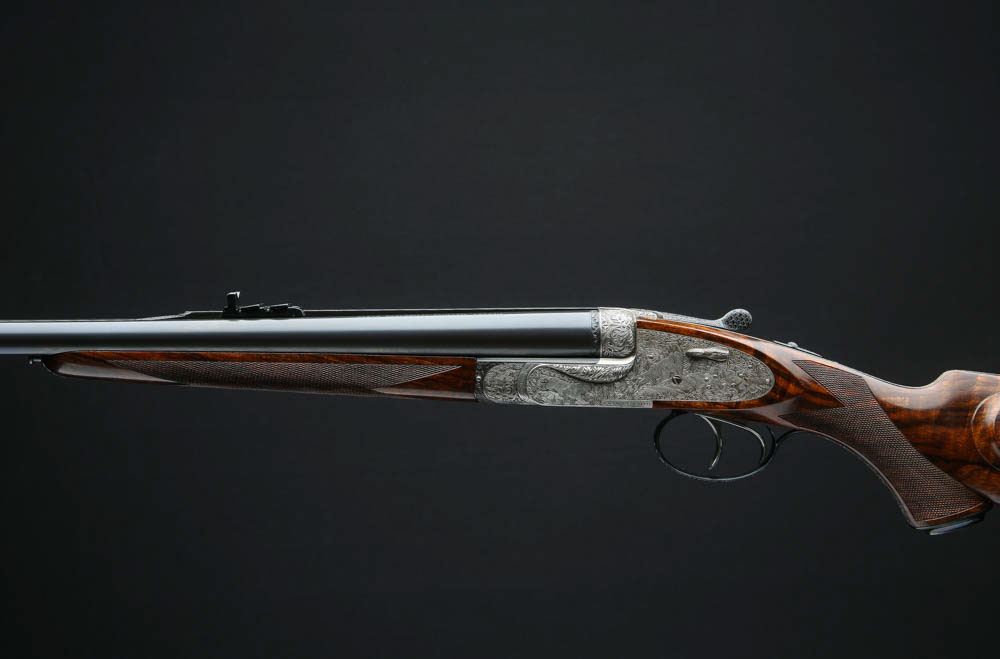
It would be impossible to assemble a list of the top dangerous game cartridges without including the .470 NE, which is the best known and most common of the Nitro Express cartridges. Most people link its popularity—and rightly so—with Robert Ruark who sang the praises of his Westley-Richards .470 NE in Use Enough Gun.
Lord knows how many impressionable young minds became fixed on the idea of owning a .470 double after reading Ruark. I know I was one.
The .470 NE came to life as a replacement for the .450 3 ¼” NE, which was an excellent dangerous game cartridge that was outlawed in 1907 (along with all other .45-caliber ammunition) in the British colonies of India and Sudan because its bullets could be pulled from their casings and used by rebellious natives carrying .577/.450 Martini Henry rifles.
Factory .470 NE ammo is available from a number of sources and shooters have a wide range of bullet styles to pick among. The most common offering is a 500-grain bullet at 2,150 fps, generating 5,132 foot-pounds of energy at the muzzle.
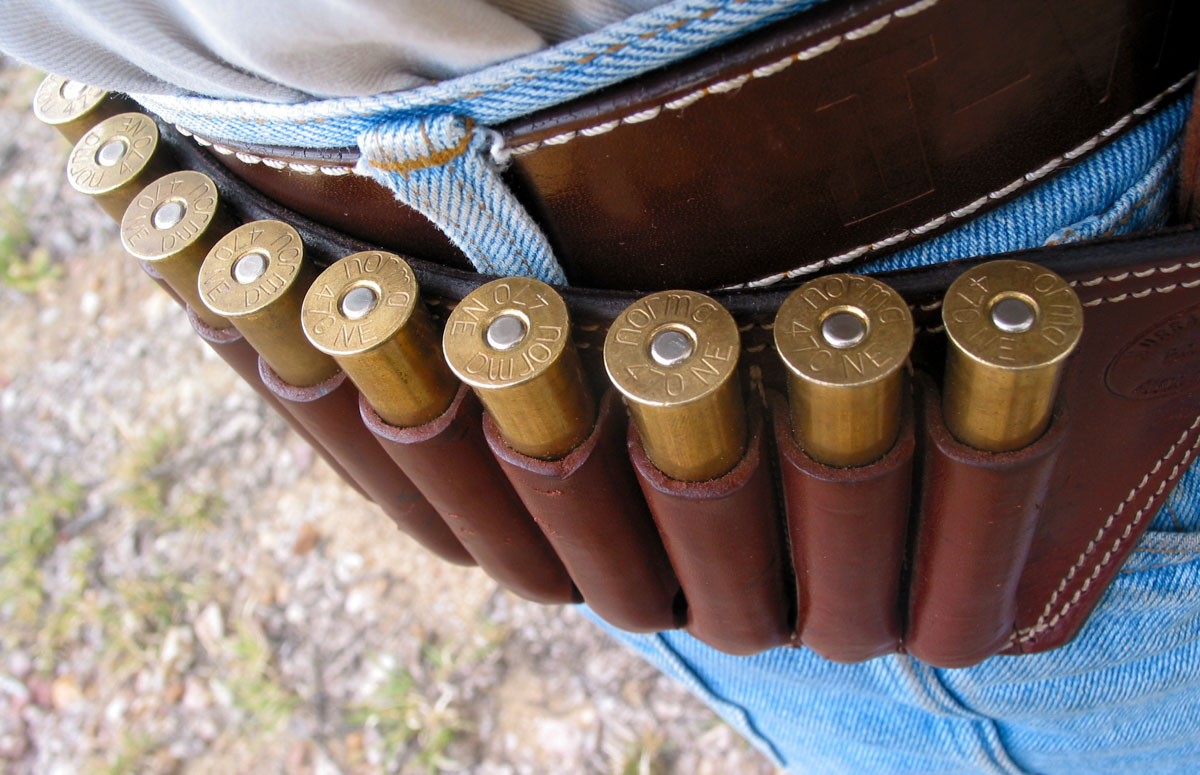
I’ve seen what this magnificent cartridge can do first-hand on elephant and giraffe and there’s no doubt as to its stopping abilities.
The .470 NE is at the top end of what most sport hunters can handle, both in terms of recoil and rifle weight. Once you get into the realm of the dedicated elephant rounds such as the .577 NE, .600 NE, and .700 NE, the heft of those guns makes them difficult to haul around in the brush, to say nothing of the recoil and cost.
Modern side-by-side double rifles chambered in the .470 NE include the Heym Model 89B, Chapuis Progress Series 3, Sabatti Safari Big Five Express, and Merkel 140 AE. These are all “affordable” .470s, meaning that you can get them for about $8,000 to $35,000 depending on the specifics of the build. This is in contrast to bespoke .470s from the likes of Holland and Holland and Westley-Richards that cost many times more.
.375 Ruger
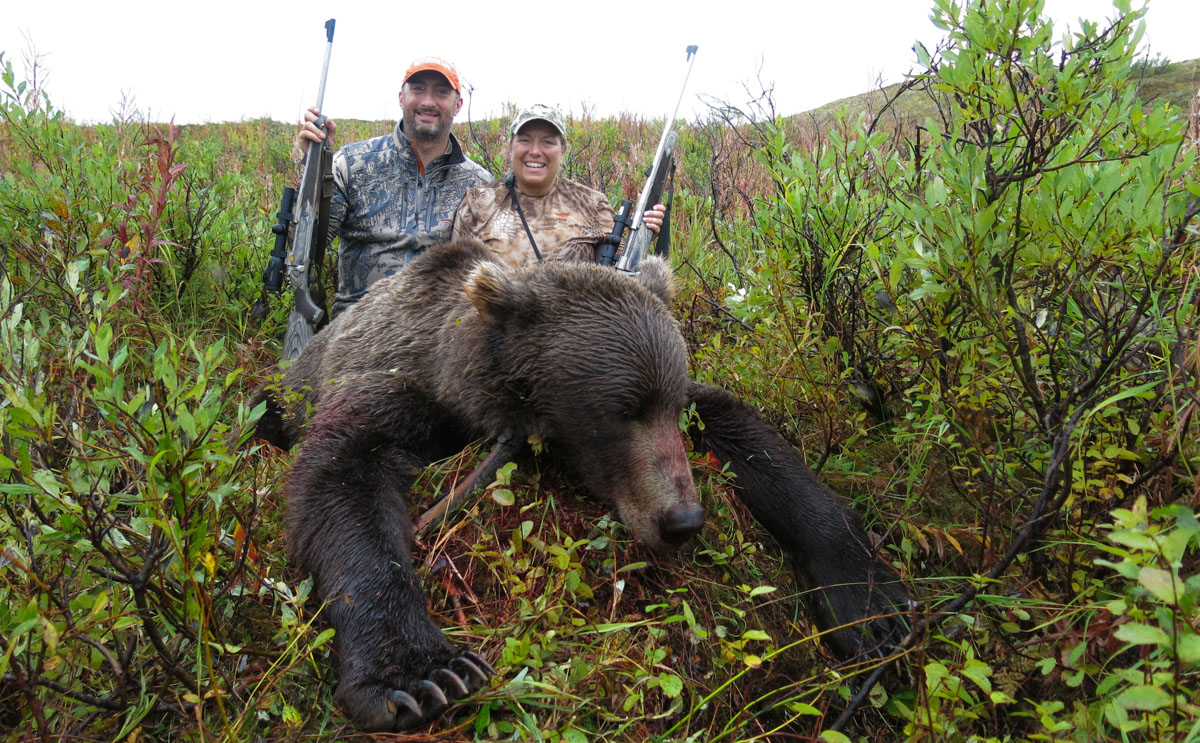
The .375 Ruger has become one of my favorite rounds of late. It was introduced in 2007 amid a flurry of new cartridges and never really caught on the way it should have. That was for two reasons. One, it sort of got lost in the mix of WSMs, Creedmoors, proprietary Noslers and others, and, two, new cartridges that are larger than .30-caliber have a tough time making headway with the majority of hunters and shooters.
But I think the virtues of the cartridge will make it a success in the long run. It is a new and arguably improved version of the .375 H&H built along the principals of modern cartridge design.
What it brings to the party is .375 H&H ballistics in a smaller action and shorter barrel length. And because of the case design, it will be inherently more accurate. Shooting 270- and 300-grain bullets out of a 20-inch barrel (versus the .375 H&H’s 24-inch barrel standard) it achieves the same muzzle velocities. And because the .375 Ruger uses a shorter standard-length (.30/06 sized) action, rifles chambered in it are much more economical. All things being equal, a shorter action is also stiffer, another boon to precise shot placement.
I’ve shot the .375 Ruger in rifles from Ruger and Mossberg and both delivered excellent accuracy. The Mossberg Patriot came along with me on a couple trips to Alaska where I used it on brown bear in the Togiak Wildlife Refuge.

The .375 Ruger case is an original design (and the parent case to the .300 PRC) that has less taper and a sharper shoulder than the .375 H&H, and because it also lacks the .375 H&H’s belt, it has greater powder capacity than the classic magnum. If you were to fault the cartridge for anything, you could say that the minimal case taper makes it less likely to feed well and extract under duress and that ammo availability isn’t on par with the .375 H&H.
Both points have some merit, but less than their advocates suggest. The need for cartridges with extreme tapers has lessened with the advent of modern temperature-stable powders. As for ammo availability, I’ve never been in a situation where me and my buddies have run out of ammo or didn’t have ammo arrive with us on a trip. Not that it couldn’t happened. But it is exceedingly rare.
Point is, if you’re a fan of modern cartridges and want an even better engineered version of the classic .375 H&H, then the .375 Ruger—the newest addition to the pantheon of the best dangerous game cartridges—is for you.
.458 Winchester Magnum

The .458 Win. Mag. got off to a rough start in life. In the beginning it was plagued with some manufacturing gremlins that resulted in some cases shipping from the factory with too little powder. This led to a cascading series of events involving high-profile failures on dangerous game in Africa and series of rumors about the cartridge that nearly derailed it from the beginning. The creation of the .458 Lott and other cartridges were meant to address the .458 Win. Mag.’s perceived shortcomings.
The issue with powder slopping out during the manufacturing process—which Winchester fixed early on—came to light about 13 years ago. Prior to that, conjecture and hearsay blamed the .458 Win. Mag.’s woes on compressed powder loads, under-bore bullets, and faulty cartridge design. To this day, there are those who view the .458 Win. Mag. with suspicion and insist the old rumors are true. Had those rumor gained more traction, the .458 Win. Mag. might be a footnote in history rather than one of our best dangerous game rounds.
Despite this, the .458 Win. Mag. has endured and has a long and successful track record as one of the best dangerous game rounds in Africa. It was introduced in 1956 by Winchester and offered in the company’s Model 70 African. This was a big deal for American shooters, because the rifles and ammunition were much more affordable than classic British guns and chamberings. It was also a big deal for African guides and game scouts who found the .458 Win. Mag. to be within their budgets and they ended up carrying them afield for their work as well.
The initial advertised load was a 510-grain bullet at 2,150 fps from a 26-inch barrel (a barrel length, incidentally, that few if any .458s have ever employed). Many accounts suggest that it was difficult to achieve that with factory-loaded ammo in the shorter barrels most hunters carried. But that didn’t stop the .458 from knocking down dangerous game in Africa, Alaska, and beyond.
With modern bullets and propellants, the .458 Win. Mag. is more lethal than ever. Hitting that 2,150 fps mark from 24-inch barrels with 500-grain bullets isn’t an issue. Speaking of bullets, there are a huge number of great projectiles to choose from. In the 500-grain category you have Swift A-Frames, Hornady’s DGX, Federal’s Woodleigh Hydro Solid, Nosler’s Partition, and others. Barnes makes a 450-grain TSX that’s deadly, and if you want to go lighter still, there’s the 400-grain Trophy Bonded Bear Claw.
Shooting a .458 Win. Mag. isn’t an experience you’ll soon forget. It was designed to hit the benchmark set by the .450 3 ¼” NE, the consummate dangerous-game round of its era. Those who feel that isn’t enough and want to delve into the .458 Lotts of the world are free to do so, but anyone shouldering a .458 Win. Mag. is never undergunned.
.45/70 Gov’t.
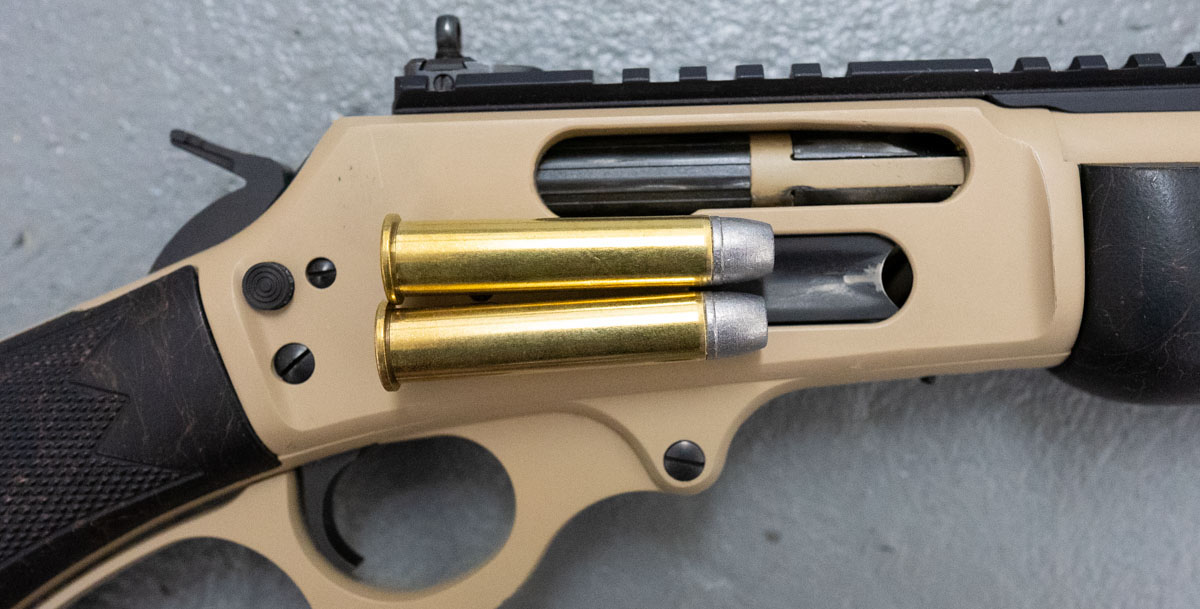
When introduced in 1873, the .45/70 was hot stuff, but would hardly qualify as a dangerous game round by today’s standards. The initial charge of 70 grains of black powder propelled a .45-caliber bullet weighing 450-grains at about 1,350 fps, which was as much excitement as the Springfield 1873 Trapdoors it was paired with could handle.
But beefed-up actions capable of handling higher pressures, along with better bullets and propellants, have transformed the .45/70 into something much more formidable. When chambered in short-barreled lever guns with extended magazines, ghost-ring sights, and slicked up actions, the .45/70 has become a go-to option for guides and hunters in Alaska who want a fast-handling rifle that carries a lot of firepower when creeping through the thickets that big bears call home.
The success of the .45/70 in this role has been noticed even in Africa, where lever guns chambered in it have been used on Cape buffalo and other large critters.
The generous volume of the .45/70’s case has led to the development of many +P loads that are true thumpers. One example is the Grizzly cartridge 420-grain flat nose hard cast bullet at 1,950 fps that carries 3,547 foot-pounds of muzzle energy. Buffalo Bore makes some hard-hitting .45/70 loads too. Their 430-grain hard-cast has a muzzle velocity of 1,925 fps (3,937 ft-lb.) and they also load a 380-grain Monometal bullet at 2,075 fps/3,632 foot-pounds. Performance like that is what has propelled the .45/70 into the realm of the best dangerous game cartridges.
.404 Jeffery
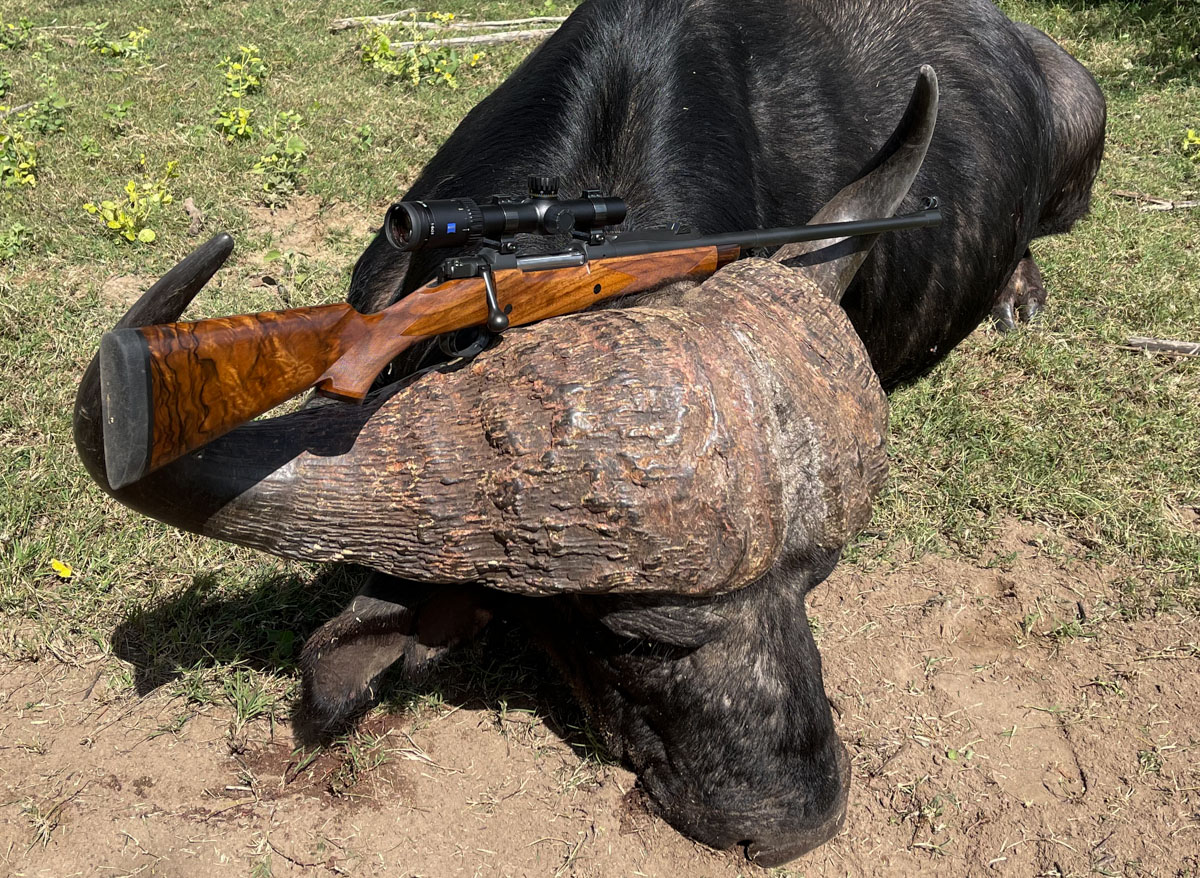
Even if you haven’t shot the .404 Jeffery, there’s a good chance you’ve cavorted with some of its offspring. The .404 is a viable dangerous game round in its own right, but part of its resurgent popularity is due to the numerous modern cartridges that are based on its case.
These include Nosler’s 26, 27, 28, 30 and 33; the Winchester Short Mags (WSMs); the Remington Ultra Mags (RUMs), and Short-Action Ultra Mags (SAUMs); and a bunch of others. (The .404’s case capacity and beltless design are two of the reasons it has been a popular platform for so many modern rounds.) Some fans of those cartridges have taken a look at the .404 Jeffery and decided that it is the best dangerous game round for them.
It is one of the older cartridges on this list, developed in the early 1900s (1905 or so depending on the source) for use in bolt-action rifles. It fired 300- and 400-grain bullets at 2,600 and 2,150 fps respectively, putting it a notch below the .416 Rigby in terms of energy and recoil.
Its relatively mild nature is one reason it found favor with hunters, scouts, and guides. Prior to World War II it was more popular than the .416, but it faded from the scene in the 1950s and remained obscure until relatively recently.

Now don’t expect to run down to your local gun store and grab one off the shelves. Production guns in .404 Jeffery are limited and I’m not sure any major rifle maker is producing one at the moment. But you can find used examples on gun auction sites built on actions like the CZ 550, Montana Rifle Company 1999, and, of course Mausers. Heym has also built their “Express” Magnum Bolt Actions in the .404 as well. A good friend of mine just had a custom .404 Jeffery built on a CZ action, which is another option, and took it to Africa where he killed his first Cape buffalo.
Ammo in .404 Jeffery available from Hornady and Norma.
.416 Remington
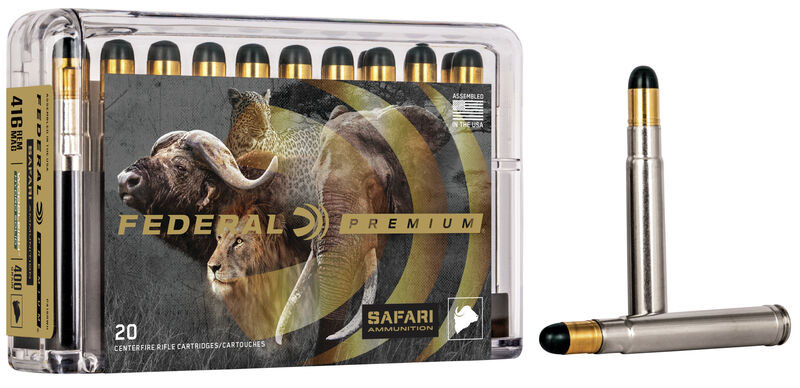
The first .416 Remington I observed up close was in the hands of an Alaskan bear guide who was crawling through the grass in front of me as we put the stalk on a giant black bear nearly 20 years ago. Hers was a Blaser rifle with a thumb-hole stock. She’s sworn by that rifle and cartridge and has used it as a back-up gun for years on browns and grizzlies, and for her own hunting in Alaska and Africa.
Lots of professionals like her turned to the .416 Rem. as a potent round that duplicated the legendary .416 Rigby but was available in rifles that cost less. The .416 Rem. was introduced in 1989 by Big Green and soon gathered a devoted following. Capable of launching 400-grain bullets at 2,400 fps, the .416 Rem. has an impressive 5,115 foot-pounds of energy at the muzzle, placing it squarely in the midst of today’s best dangerous game cartridges. Hornady, Norma and Nosler offer .416 Rem. ammo, and if you want to handload monometal bullets the 350-grain Barnes TSX and TTSX are good options.
Though the .416 Rem. isn’t going anywhere for the moment, its appeal has peaked. If anything, it’s a victim of its own initial success. After Remington launched it, the .416 Rigby got a boost in interest, with companies like Ruger and Hornady jumping into the fray to support the older round.
Now we also have the .416 Ruger, which does for the .416 Rigby what the .375 Ruger did for the .375 H&H. On paper, the .416 Ruger eliminates the rationale for the .416 Rem. by taking the cost savings and performance gains to another level. Now I don’t think the .416 Ruger has much hope of overtaking either the Remington or the Rigby, which is why it didn’t make the list of top dangerous game rounds, but by adding another option to the world of .416-caliber cartridges it makes the prospects for the .416 Rem. that much dimmer.
.505 Gibbs

Go big or go home. That’s the only way to describe this formidable cartridge that has a case capacity so large that you can hear an echo when you yell into it. It was designed in 1910 by George Gibbs and is curious because not only is it about the largest sporting round one can stuff into an internal-magazine bolt action, but it also employs a non-standard .505-caliber bullet.
Is the Gibbs for you? If you hate your shoulder, love shooting esoteric rounds with hard-to-find components and have the chance to get face-to-face with thick-skinned dangerous game like elephant, then the answer might be yes.
Unless an expensive custom rifle is in your future, your best chance of acquiring a Gibbs is in the used gun market. CZ and Montana Rifle Company both produced .505 Gibbs’ in the past and any number of smaller gun makers have built them on Mausers, M1999, and CZ 550 actions.
If you do find a used Gibbs, one thing you don’t have to worry about is whether the barrel is shot out. I doubt many .505s ever built have more than 100 rounds through them.
A look at the numbers explains why. The 600-grain solids at 2,100 fps crank out 5,877 foot-pounds of muzzle energy. The original load, 525-grain bullets at a published 2,300 fps ups the muzzle energy to 6,100 foot-pounds—though pushing those solids at 2,200 fps is a more realistic (and completely adequate) threshold. Norma loads 540-grain solids at 2,300 fps (6,345 foot-pounds) if you want to crank the .505 up to eleven.
The Gibbs might appeal to those with a literary bent, as it was the rifle carried by Robert Wilson, the Professional Hunter in Hemingway’s classic story “The Short Happy Life of Francis Macomber.”
9.3x62mm Mauser

If the .505 Gibbs is at one end of the spectrum of dangerous game cartridges, the 9.3×62 Mauser is at the other. While the legal minimum for hunting dangerous game in Africa is often the .375 H&H—depending on the country—exceptions have been made for smaller 9.3x62mm Mauser, which has proved its mettle on game around the world.
Being a goofy metric, Americans by and large haven’t paid much attention to this well-balanced round, which was introduced by Otto Bock in 1905, but European and Canadian hunters have embraced it from the get-go.
In fact, this round caused British gun makers of the time to sit up and take notice. Designed to work with the Mauser 98 action and the still-new smokeless powders, it was affordable and effective, and spurred the creation of the .375 H&H Magnum and other medium-bores.
As a pure-dangerous game round it isn’t the best choice, but as an all-around big-game round that can handle buffalo, cats, and big bears—along with everything else—it has few, if any, equals.
I used a 9.3x62mm on driven game in Poland, and the round rocked the biggest boars, including a 300-pound kyler with 6-inch tusks. I wouldn’t hesitate to take one to Africa or Alaska and use it on bigger, more dangerous game.
Despite its relative obscurity in America, lots of ammo manufacturers load the round. Federal, Nosler, Hornady, and Norma all have the 9.3×62 in their lineups. For use on Cape buffalo and the like the bullet choices include Swift A-Frames, Nosler Partitions, Woodleigh Hydro Solids, all weighing 286-grains. At a muzzle velocity of 2,350 fps these bullets generate 3,500 foot-pounds of energy. Factory ammo can be had from Hornady, Federal, Nosler, Norma and others.
Recoil on the 9.3x62mm is much more tolerable than the other cartridges on this list, which also means it can be used in lighter rifles that are easier to manage over a long day of hunting.
Another factor in the 9.3×62’s favor is there is no shortage of gun makers producing rifles in it such as Sako, Mauser, Sauer and, until recently, CZ.
If you dream of hunting Africa, but are more likely to chase bear, moose, or elk, this is a round worth looking at.




